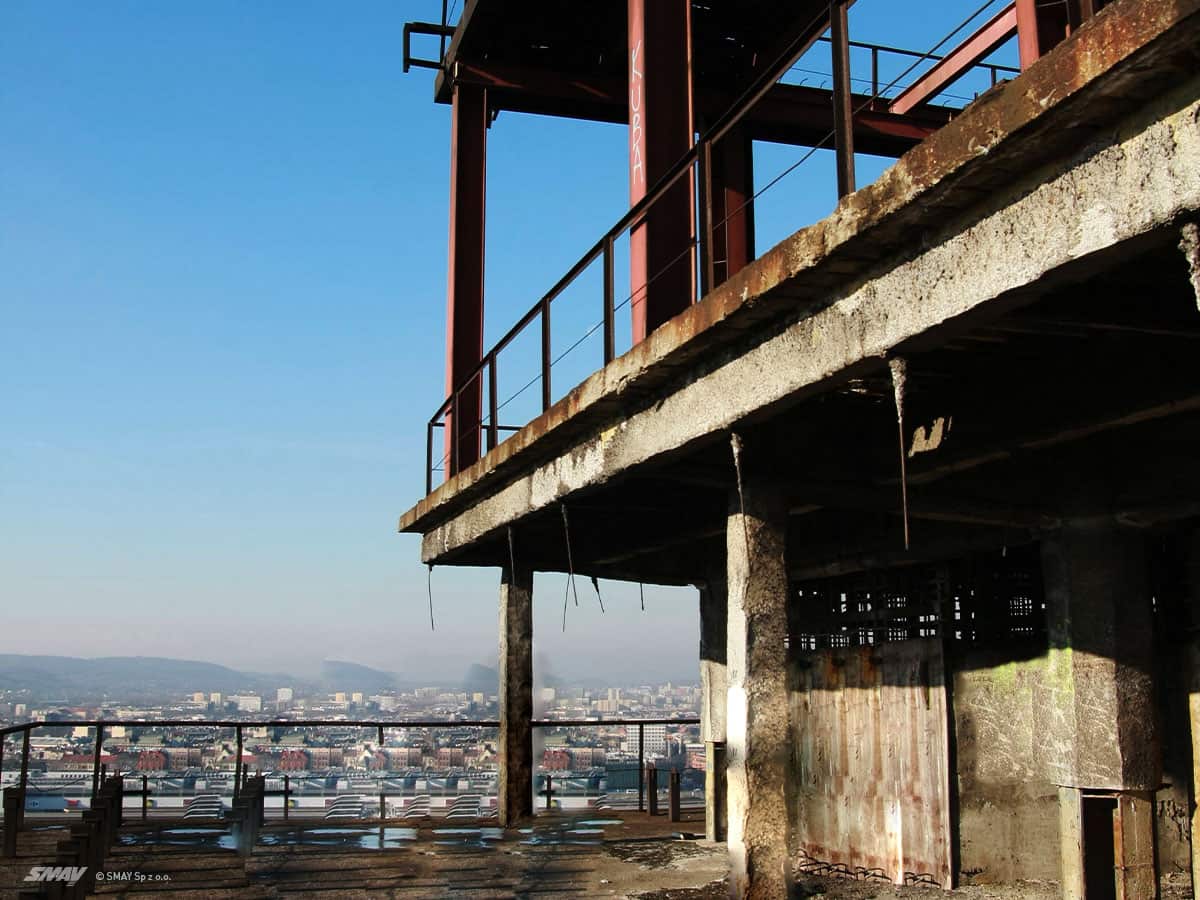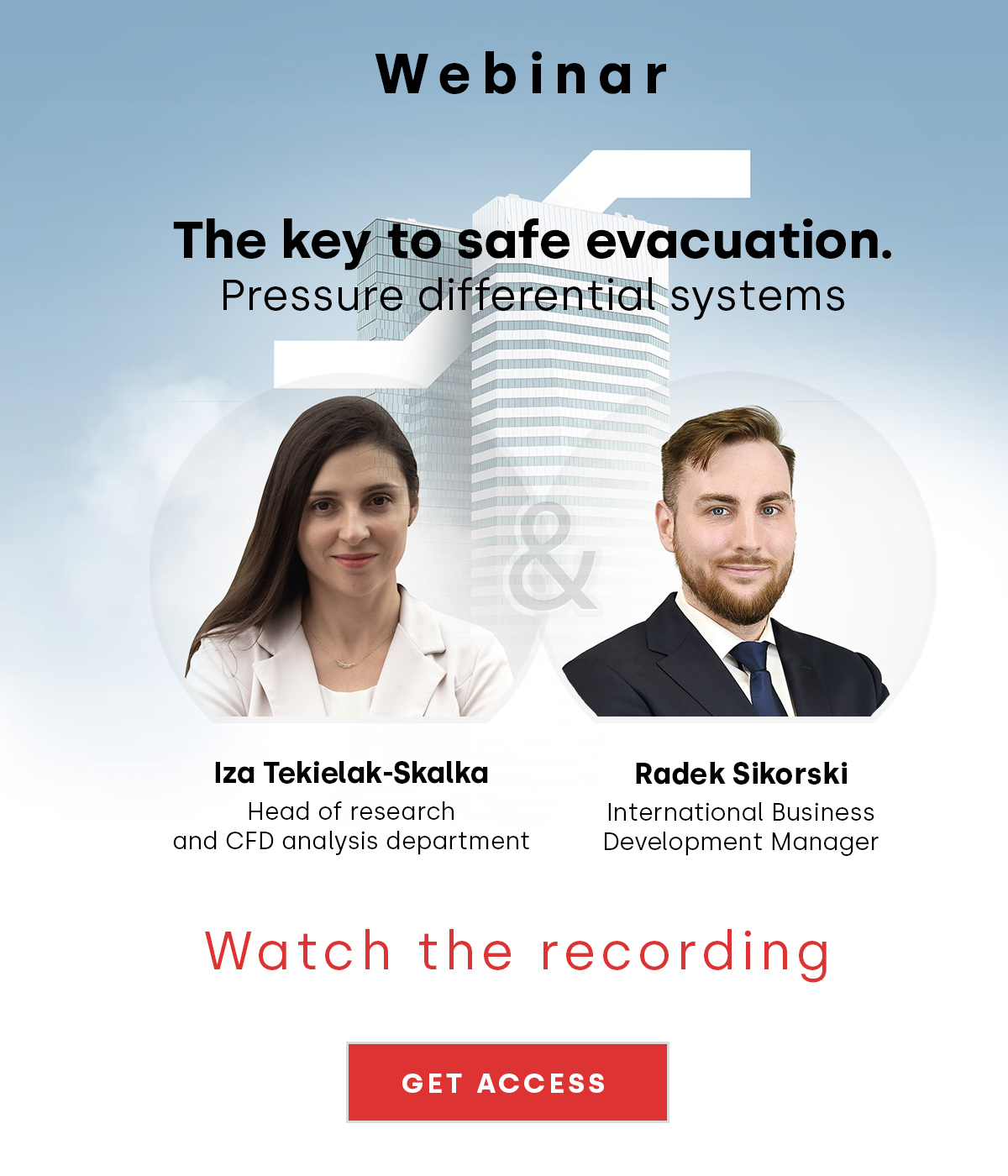How was an innovative overpressure solution that protects buildings against fire developed?

The study was conducted in four main stages:
1) Prepare study principles (scientific consultations).
2) Built a test site in the Treimorfa building in Krakow.
3) Conduct on-site tests on a real scale.
4) Conduct a result analysis and draw up a final report, including a qualifying rating.
Project description
STAGE 1 – Prepare project scenarios, principles and computer simulations
15/10/2008–16/12/2008.
At the very first stage, we worked out theoretical research principles based on an analysis of physical phenomena responsible for the formation of pressure and airflow. We conducted a large number of computer simulations that would then be verified during actual testing. We also made a technical concept required in order to select a suitable testing facility. Its staircase had to be at least 55 m high.
We settled on a high-rise building located by Lubomirskiego street in Krakow, owned by Treimorfa Project. The building is 90 m high and has 23 floors. It was unfinished and turned out to be the perfect place for the tests. We invited academic researchers from the Warsaw University of Technology and the Tadeusz Kościuszko University of Technology to participate in the project. The project was partly financed by the European Union.
MORE ON the Safety Way – Pressure Differential System
The unique solution created by SMAY uses calculation algorithms and special fan parameters that allow the system to automatically adapt to different conditions subject to physical phenomena, i.e. the stack effect, convection, expansion, wind pressure and suction, air resistance within staircases and the impact of comfort ventilation and people activities (opening and closing doors, windows, etc.).
Following the study, SMAY launched a number of initiatives aimed at presenting the results and recommendations on the safest vertical evacuation route protection systems to the public. One of them was a meeting of the Technical Group of the European Committee for Standardization (CEN/TC191/SC1/WG6/TG1) held in the SMAY main office in Krakow. The Committee was then working on a new version of the EN 12101-6 standard. During the meeting that took place in June 2010 we presented both the system and test results obtained in the Treimorfa building.
Upon familiarizing themselves with the study and its results, the Committee members unanimously stated that the previous multi-point systems were unable to meet the functional requirements of the standards in all conditions and could only be deemed reliable in favourable environment conditions.
We also ran a series of free-of-charge training sessions as part of the Fire Ventilation Academy around Poland. They were available for everyone interested in fire safety. The sessions generated a lot of interest with several hundred participants within the first few months, and thousands of people watching educational films and reading materials distributed at various conferences and published in trade press. In 2012, we also set up the Fire Ventilation Lab at the Warsaw University of Technology. Its creation was a joint effort by SMAY, Plum Sp. z o.o. and Warsaw University of Technology’s Faculty of Environmental Engineering. The laboratory’s main goal is to educate students who major in technical fields.
In 2012, the laboratory of the I.F.I. Institute of Industrial Aerodynamics in Aachen conducted a series of additional studies on the aerodynamic properties and effectiveness of the iSway® set following the study procedure defined in the EN 12101-6 standard. The study showed that the device accurately controls the nominal value of differential pressure while also automatically adjusts to changes in the test procedure. The research reaffirmed iSway® set’s full adaptability within the tested airflow range.
The Safety Way solutions are registered in the Patent Office of the Republic of Poland and the European Patent Office (EPO) in Munich (a European invention patent). The patent was granted for the following: “A means of pressure regulation in vertical escape routes” (certificate number: 218095) and “Overpressure vertical escape route protection system against smoke” (certificate number: 218694). It is the world’s first smart flow (overpressure) system.
It was first used in Poland in the state-of-the-art Vinci Office Center located at Opolska Street in Krakow.
In 2010, Safety Way was implemented as an escape route protection system in the tallest building in Poland – Sky Tower in Wroclaw. The iSway® sets are currently used in the most prestigious sites around Poland. These are Złota 44, Warsaw Spire, Mennica Legacy Tower, TAURON Arena and many others.
Autorzy

Piotr Dąbrowski

Agnieszka Szybowska-Mróz
Safety Way: an innovative differential pressure system – escape routes free from smoke and fire – highest degree of protection.
The Safety Way differential pressure system is a solution designed for multi-storey buildings:
- iSWAY-FC® differential pressure product for smoke and heat control systems;
- Innovative predictive algorithm;
- Anti-Frost system that endures even the most extreme weather conditions;
- 24-hour automatic test of all the components;
- Automatic adaptation to changing service conditions;
- Communication between individual components of the set and continuous tracking of all components (regulators, remote pressure sensors, etc.);
- Continuous measurement of the set value of static differential pressure between the protected and reference zones by the P-MAC(F) sensor.
Do you want to know more? Visit our BLOG. Our experts will provide you with a full knowledge base on ventilation and fire protection.
Do you need advice? Contact our advisor department.





